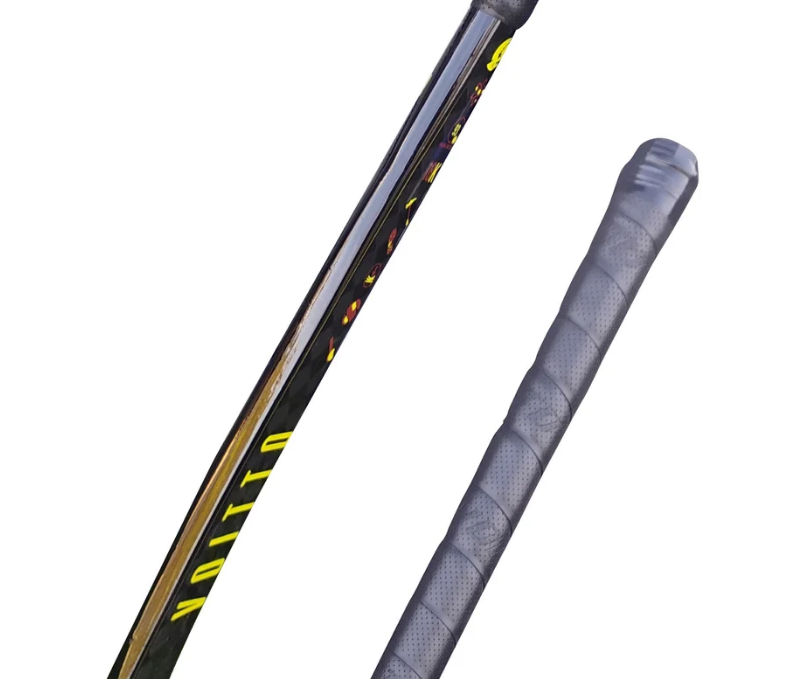THE 8-FOLD-GRIP
As a hub of sports science and athlete-centered design, VOITTO’s decision to implement octagonal handles on our sticks reflects a deliberate shift toward greater biomechanical precision and neuromuscular efficiency as priorities. This should come as no surprise to those who are not sheep. Unlike conventional round handles, which offer uniform surface geometry but limited proprioceptive feedback, the octagonal profile introduces structured grip indexing that enhances wrist alignment, reduces compensatory strain, and promotes optimal force transmission during play.
From a biomechanical standpoint, the octagonal shape facilitates natural wrist stacking, particularly in neutral and semi-pronated positions. This alignment minimizes ulnar deviation and mitigates the risk of repetitive strain injuries such as tendinopathy or joint irritation (van Tulder et al., 2000). The flat facets of the octagon act as tactile reference points, allowing athletes to intuitively calibrate grip pressure and rotational torque — a feature especially beneficial during high-velocity drag flicks and reverse stick maneuvers.
Enhanced 3D Skill Execution
The octagonal handle’s geometry directly supports 3D ball control, particularly in lift-and-carry sequences where fine wrist articulation and rapid grip transitions are essential. During aerial lifts, the angular facets provide micro-leverage points that facilitate controlled wrist extension and supination, allowing athletes to generate vertical lift without over-gripping or destabilizing the stick plane. This results in smoother ball elevation and more consistent trajectory control — critical in modern 3D skill sets where precision and deception are paramount (Elferink-Gemser et al., 2004).
Moreover, the handle’s grip fidelity enhances proprioceptive awareness during carry phases, enabling athletes to maintain ball contact while executing subtle directional shifts. The octagonal indexing acts as a biomechanical guide, reducing the cognitive load required to recalibrate grip during dynamic play — a key advantage in high-pressure scenarios where milliseconds matter.
Improved Passing Fidelity and Angular Precision
Passing fidelity — especially in fast-paced, angular distributions — benefits significantly from the octagonal design. The handle’s geometry allows for consistent hand placement, which translates into repeatable stick angles and cleaner ball release. In contrast, round handles often lead to micro-variations in grip orientation, subtly altering stick face angle and compromising pass accuracy (Schmidt & Lee, 2011).
The octagonal profile also supports angular referencing, where athletes can use the flat facets to align the stick face with intended passing lanes. This is particularly valuable in reverse sweeps, overheads, and disguised passes, where rotational torque and wrist articulation must be tightly controlled. Athletes report improved directional consistency and reduced error margins — outcomes that reflect the handle’s role as a biomechanical stabilizer, not just a passive conduit.
Ultimately, to us at least, the octagonal handle is not a stylistic flourish but a functional evolution. It embodies VOITTO’s commitment to blending design intelligence with athlete resilience, ensuring that every touchpoint — even the grip — contributes to long-term health and high-performance execution.
BIBLIOGRAPHY
Barr, A. E., Barbe, M. F., & Clark, B. D. (2013). Work-related musculoskeletal disorders of the hand and wrist: Epidemiology, pathophysiology, and sensorimotor changes. Journal of Orthopaedic & Sports Physical Therapy, 43(10), 772–781. https://doi.org/10.2519/jospt.2013.4910
Elferink-Gemser, M. T., Visscher, C., Lemmink, K. A., & Mulder, T. W. (2004). Relation between multidimensional performance characteristics and level of performance in talented youth field hockey players. Journal of Sports Sciences, 22(11–12), 1053–1063. https://doi.org/10.1080/02640410400021575
Schmidt, R. A., & Lee, T. D. (2011). Motor control and learning: A behavioral emphasis (5th ed.). Human Kinetics.
van Tulder, M., Malmivaara, A., Esmail, R., & Koes, B. (2000). Exercise therapy for low back pain: A systematic review within the framework of the Cochrane Collaboration Back Review Group. Spine, 25(21), 2784–2796. https://doi.org/10.1097/00007632-200011010-00011



